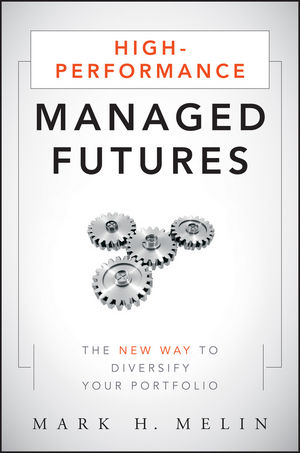High-Performance Managed Futures: The New Way to Diversify Your PortfolioISBN: 978-0-470-63793-7
Hardcover
320 pages
September 2010
 This title is out-of-print and not currently available for purchase from this site.
|
Preface.
Acknowledgments.
Chapter One: Understand It - The Truth About Risk and Misunderstood Investments.
What is this “Managed Futures” I've Never Heard About?
The Stock Market is NOT “Safe” and “Conservative” and Does Not Offer True Diversification
Providing Balance: Dissenting Views of Managed Futures Performance.
It Works In Practice But Does It Work in Theory?
In Managed Futures Diversification, Not Cash, is King.
Chapter Two: Define It: Establish Performance and Risk Targets.
The Simple Managed Futures Definition.
Target Risk / Reward profiles.
Chapter Three: Work With It: Build Basic Portfolios Using Targets.
Portfolio Diversification Vs Individual Manager Selection.
Individual CTA Analysis / Portfolio Considerations.
Chapter Four: Realize It: The Old Way vs. High Performance.
The Fastest Growing Asset Class?
This Unique and Very Special Asset Class.
Managed Futures Defined.
Decoding the D Doc.
Chapter Five: Don't be a Victim: Leverage Managed Futures Regulation and Account Structure to Avoid “Hedge Fund Fraud”.
Managed Futures Regulation and Account Structure / Protection.
Transparency: The Ability to See and Understand an Investment
Auditing Performance and Money Flow.
Tight Regulatory Control: Meet the NFA and CFTC..
Chapter Six: Recognize It: Volatility + Volatility and Lintner's Message.
Volatility Used to Reduce Volatility.
All Volatility Is Risky… To Different Degrees.
Study One: How “Bad” Is Volatility?
Standard Deviation as Measure of Volatility.
Chapter Seven: Use It: Reward Adjusted Deviation (RAD) Considers Past Probability and Rewards Success.
The Test of Success.
Study #1: Exploring RAD with Math.
Study #2: Average Drawdown: Comparing RAD VS STD When Actual Risk Improves.
Study #3: Where CTAs Fall Based on RAD.
Risk “Indicators” Don't Indicate Risk.
Chapter Eight: Principal Protected Conservative and Risky Investments.
Don't Be Fooled.
Four Steps to Creating Principal Protected Products.
Strategies to Maximize Return.
Chapter Nine: Use All of It: Overlooked Points of Correlation.
Is Managed Futures the World’s Most Non-Correlated Asset?
Balance Risk & Return: Managed Futures Cushion During Stock Turbulence.
Correlation Study: Major Indexes.
Managed Futures Non-Correlation Is Not an Accident.
Agricultural Traders Don't Necessarily Correlate to Ag Markets.
Traditional Returns-based Correlation Logic Is Faulty.
Non-Correlation with Stocks Could Be the Investor’s Best Friend.
Chapter Ten: Build It: CTA Evaluation and Portfolio Construction.
Translating Investor Goals into Portfolio Design Strategy.
What is the “Best” Method to Identify Successful CTAs?
Portfolio Building with Volatility Skewing.
High Performance Managed Futures Portfolio Building Exercise.
Step Four: Detailed Due Dilligance.
Why Investors Must Look Past Simple Average Return Headlines.
The “Hidden” Risk in Un-even Returns Distribution.
Which Portfolio Do You Prefer?
Chapter Eleven: Understand It: The Naked Truth Behind Managed Futures Risk.
The Simple Way to Look at Risk Management: Choke Points.
Leverage Can Magnify Wins as Well as Loses; Just Ask a Banker.
Exploring Individual Manager Risk.
Fraud Risk.
Chapter Twelve: Don’t Sit Back: Active Management of Risky Investments.
Are The Biggest Risks Those That Are Unknown?
A Graphical Look at the Managed Futures Account
Individual Manager Risk.
Wrapping It Up.
Conclusion.
Research Methodology.
Notes.
About the Author.
Index.



